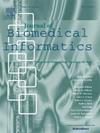一个基于转换器的框架,用于具有图形增强表示的时间健康事件预测
IF 4.5
2区 医学
Q2 COMPUTER SCIENCE, INTERDISCIPLINARY APPLICATIONS
引用次数: 0
摘要
目的:近年来,深度学习方法在预测时间健康事件方面显示出巨大的潜力。然而,现有的方法并没有充分利用合并症之间复杂的相互作用,并且忽略了入院记录中的不平衡和时间不规则性。方法:本研究提出了GLT-Net,这是一种将图学习与Transformer框架相结合的深度学习方法来解决这些挑战。GLT-Net首先构建一个患者关联图,为每个个体生成独特的表示。同时,利用诊断码的层次结构对诊断码嵌入进行预训练。随后,创建共病关联矩阵来说明共病之间的关系,并使用图神经网络来增强诊断代码的特征表示。最后,转换器-编码器框架通过合并时间信息来捕获历史准入记录中的依赖关系。结果:我们在时间健康事件预测的两个任务上展示了我们的方法。在真实数据集上的实验结果表明,GLT-Net在预测时间健康事件方面优于基线模型。此外,一个案例研究证明了GLT-Net在预测卫生事件方面的有效性。结论:了解随时间的进展模式、合并症关联和患者特征对于预测时间健康事件至关重要。我们的研究为更深入地了解患者健康状况和疾病趋势提供了新的见解和方法。此外,我们的模型可以扩展到其他数据源,增强了其通用性。本文章由计算机程序翻译,如有差异,请以英文原文为准。

A transformer-based framework for temporal health event prediction with graph-enhanced representations
Objective:
Deep learning approaches have demonstrated significant potential in predicting temporal health events in recent years. However, existing methods have not fully leveraged the complex interactions among comorbidities and have overlooked imbalances and temporal irregularities in admission records.
Methods:
This study proposes GLT-Net, a deep learning approach that combines Graph Learning with Transformer framework to tackle these challenges. GLT-Net begins by constructing a patient association graph to generate unique representations for each individual. At the same time, the hierarchical structure of diagnosis codes is utilized to pre-train the diagnosis code embeddings. Subsequently, a comorbidity association matrix is created to illustrate the relationships between comorbidities, and graph neural networks are employed to enhance the feature representations of diagnosis codes. Finally, a Transformer-Encoder framework captures the dependencies in historical admission records by incorporating time information.
Results:
We demonstrate our approach on two tasks in temporal health event predcition. Experimental results on real-world datasets show that GLT-Net outperforms baseline models in forecasting temporal health events. Additionally, a case study demonstrates the effectiveness of GLT-Net in predicting health events.
Conclusion:
Understanding progression patterns over time, comorbidity associations, and patient characterization is essential for predicting temporal health events. Our study provides new insights and methods for a deeper understanding of patient health status and disease trends. Moreover, our model can be extended to other data sources, enhancing its versatility.
求助全文
通过发布文献求助,成功后即可免费获取论文全文。
去求助
来源期刊

Journal of Biomedical Informatics
医学-计算机:跨学科应用
CiteScore
8.90
自引率
6.70%
发文量
243
审稿时长
32 days
期刊介绍:
The Journal of Biomedical Informatics reflects a commitment to high-quality original research papers, reviews, and commentaries in the area of biomedical informatics methodology. Although we publish articles motivated by applications in the biomedical sciences (for example, clinical medicine, health care, population health, and translational bioinformatics), the journal emphasizes reports of new methodologies and techniques that have general applicability and that form the basis for the evolving science of biomedical informatics. Articles on medical devices; evaluations of implemented systems (including clinical trials of information technologies); or papers that provide insight into a biological process, a specific disease, or treatment options would generally be more suitable for publication in other venues. Papers on applications of signal processing and image analysis are often more suitable for biomedical engineering journals or other informatics journals, although we do publish papers that emphasize the information management and knowledge representation/modeling issues that arise in the storage and use of biological signals and images. System descriptions are welcome if they illustrate and substantiate the underlying methodology that is the principal focus of the report and an effort is made to address the generalizability and/or range of application of that methodology. Note also that, given the international nature of JBI, papers that deal with specific languages other than English, or with country-specific health systems or approaches, are acceptable for JBI only if they offer generalizable lessons that are relevant to the broad JBI readership, regardless of their country, language, culture, or health system.
 求助内容:
求助内容: 应助结果提醒方式:
应助结果提醒方式:


